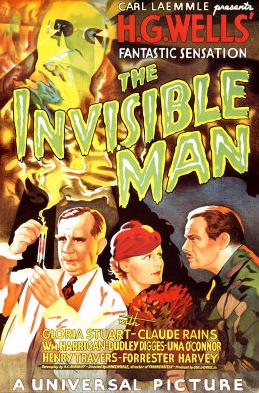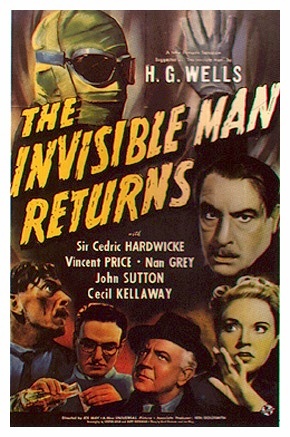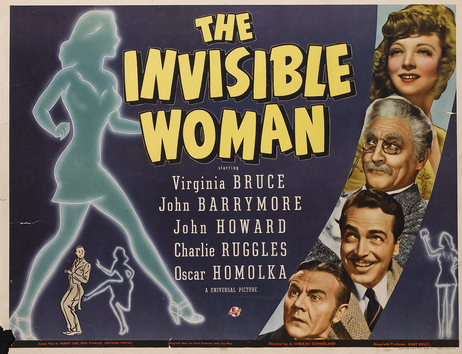The Invisible Movies - 1933 through 1940
H.G. Wells Started This
And Hollywood ran with it.
Though the orignial story was written at the end of the nineteenth century it wasn't unil 1933 that Hollywood attempted to make a movie of the story. Much like the Frankenstein and Warewolf movies, once the "box" was opened a range of movies featuring invisible people came out in quick succession.
In one instance two invisible person movies were marketed the same year; both by Universal who had exclusive license to the story.

The Invisible Man
Marketed in 1933 by Universal Pictures the movie features the talents of Claude Rains as Griffin (the invisible man), Gloria Stuart as Flora, Griffin's girlfriend, William Harrigan as Kemp (a school chum of Griffin), and Henry Travers as Dr. Cranley another associate of Griffin.
Frankly the movie is way over the top, but most horror films of the period were. Perhaps what makes this film most notable is the director, James Whale, the very same director of the first Frankenstein movie in 1931.
Billed as Science Fiction and Horror it does have some humor in it, though that humor is relegated to secondary characters. In one scene the police inspector Bird, investigating the odd doings in the area, asks a bar patron what happened. The patron replies that "All of a sudden something takes hold of me hat and throws it in the pond." The inspector asks how many drinks the patron has had and the man replies "Only a couple sir, that's all."
The inspector Bird replies "A couple of drinks and a gust of wind. So much for you!"
Though Well's original story never did explain why Griffin went mad, the writer,R.C. Sherriff makes it plain that the very drug that makes Griffin invisible is also causing his insanity. Rains does a marvelous job as a homicidal madman.
Special Effects
As one might expect with an "invisible person" movie there had to be special effects. This fell to the director James Whale. For most scenes where Griffin is manipulating objects wires were used, but in the scenes where Griffin removes his clothes in order to disappear Whale had Rains dress in black velvet, head to toe, and film Rains' scenes on a black velvet background. This film was then double-exposed to pick up the background scenery.
Nothing high tech here, but it is certainly similar, in a way, to blue and green screen CGI technologies of today. Had the Academy of Motion Picture Arts and Sciences had a special effects award this movie would certainly won it. The Invisible Man Returns, using the exact same techniques, was nominated for this award in 1940.
Interesting Facts
This was only Claude Rains second movie and he only appears in it at the very end when the Griffin character dies.
In the original story Well's had Griffin go insane because he could not regain visibility; in the movie the drug was responsible.
Boris Karloff was the original choice for Griffin, but Karloff begged off under protest due to repeated attempts to cut his salary. James Whale chose Rains because of his voice and diction.
H.G. Well's, having seen the film, objected to Griffin being portrayed as a lunatic rather than the brilliant scientist he'd created in the book.
The New York times named "The Invisible Man" one of the ten best films of 1933.

The Invisible Man Returns
Universal had a contract with H.G. Wells, and in an attempt to get as much mileage as possible out of the concept, launched this movie in 1940. interestingly Universal also released The Invisible Woman the same year.
In this version Vincent Price, playing the part of Geoffry Radcliffe, is condemned to death for the murder of his brother. He is innocent of the crime, but only his closest friends know this.
John Sutton, playing the part of Dr.Frank Griffin, brother of the original Invisible Man, visits Radcliffe in jail and injects him with the invisibility serum. Radcliffe promptly vanishes from his cell.
The police are initially unaware that Dr. Griffin is brother to the original Griffin and a substantial amount of the film is devoted to the police unraveling this mystery.
In the meantime Radcliffe must solve the murder of his brother to clear his own name. There's an additional constraint as well. Dr. Griffin and Racliffe both know that the invisibility serum will slowly drive Radcliffe insane and the good doctor must determine the antidote before his friend loses his mind.
In the end Radcliffe discovers who the murder is; a cousin, Richard Cobb (played by Cedric Hardwicke) who has an interest in the family company. Radclilffe is able to extract a confession from Cobb before Cobb dies, but is shot by police while invisible.
Doctor Griffin must give him a blood transfusion to keep him alive long enough to perform an operation to repair the bullet wound. As luck would have it the transfusion restores Radcliffe's visibility.
Interesting Facts
This was only Vincent Price's fourth screen appearance. As with Rains, Price was chosen for his voice and diction.
Price only appears on film for a total of one minute at the very end of the picture. Regardless Price was the actor, clad in black velvet, for those scenes where the invisible man had to appear in clothing.
As a side note Price was a bit claustrophobic, so the "black velvet" scenes were particularly difficult for him.
Special effects were accomplished the same way, with a black velvet suit and black background, as in the original film of 1933. These effects earned the film an Oscar nomination as there was no Special Effects category in 1933.
The film was shot, from beginning to end, in three months in 1939. It was released one month later, January 1940.
Though the film ran over budget at $270,000 it did well at the box office making the studio a tidy profit.

The Invislbe Woman
This film was played entirely for laughs.
The film is about a rich playboy Richard Russell (played by John Howard) who squanders his inherited wealth on parties and the occasional odd investment. One of his investments is in Professor Gibbs (played by John Barrymore [Drew Barrymore's grandfather]) who has invented an invisibility machine. Richard must get a return on his investment in kooky Gibbs to pay off or he'll go bankrupt. To demonstrate the machine the men advertise for a volunteer in the personals section of the newspaper. Only one serious respondent replies, Kitty Carrol (played by the beautiful Virginia Bruce) who has ulterior motives.
She's going to get even with her draconian boss Growley (played by Charles Lane).
Meanwhile criminals have got word about the machine and steal it in order to make their boss invisible so he can flee the country. In an attempt to get the machine back all of the players end up at the bosses hideout, captives of the notorious Blackie (played by Oskar Homolka). Eventually Kitty Carroll foils the villian's plans and the movie ends on a happy note for everyone but the crooks.
The Cast
Of all the films up to this point this one had the most top names. Virginia Bruce, with seventy-eight films to her credit and John Howard, with one hundred thirteen films to his credit were cast as the attractive department store model and handsome playboy. John Barrymore, supremely famous by the time, played the somewhat distracted, but brilliant scientist Professor Gibbs. Charles Ruggles played John Howards man servant.
Both Ruggles and Barrymore provided comic relief. Ruggles by playing a forever "resigning after this latest indignity" man-servant. Barrymore by playing a somewhat distracted and overly focused mad, but loveable scientist.
Appearances by Shemp Howard (of Three Stooges fame), Donald McBride (as Foghorn) and Oskar Homolka (as Blackie) provided additional comic relief.
Charles Lane (as Growley) provides additional support as the loudmouthed mean-spirited department store boss that Virginia Bruce more than gets even with. Lane is well known for playing just this sort of character in a large assortment of movies.
Notable Plot Points
Despite his stunning good looks John Howard is almost an afterthought. Charles Ruggles (playing George the butler) provides great comic relief with pratfalls and sarcastic comments to or about his boss.
Even though this is a 1940s comedy, Virginia Bruce's character gets even with every mean spirited boss who has ever abused one of his female employees...and then some. By the end of the film Growley is bending over backward to please his models. A complete turnabout for the once shrewish department store tyrant. I found this notable in an age long before women's liberation.
In this version invisibility is attained chemically and with an electrical machine. A relapse is possible with the consumption of alcohol. A convenient plot point for the end of the film.
Interesting Facts
Joe May, writer and director, was one of Germany's first Jewish directors to escape the Nazi persecution. He helped Fritz Lang get his start in German film and later in Hollywood.
John Barrymore is said to have ad-libbed most of his lines.
The same special effects, now dated, were used in this film as in the 1933 version and the more serious 1940 The Invisible Man Returns.
Though Shemp Howard was primarily known as one of the Three Stooges he also made numerous appearnace in Universal films with a total of one hundred eighty appearances.
Professor Gibb's lab assistant/housekeeper was played by Margaret Hamilton, who had played "wicked witch of the west" just the year before in The Wizard of Oz.
Wrapping Up
All of these film are worth a viewing. The original was a cinematic first for special effects and the undeniable talents of both Claude Rains and the director James Whale. The writing is excellent with a very chilling portrayal of a mad murderer by Claude Rains. The character Griffin, in his madness, seems to take particular delight in describing to his victim how he will be killed.
The Invisible Man Returns was a bit better polished with improved film, lighting and camera equipment. Though it is just as chilling as the first it does not seem to be quite as "over the top" as the first. Vincent Price proves, as the new invisible man, that his voice and diction mark him as a stellar actor. It was some years before Price became famous for playing horror characters for the likes of Roger Corman in "B" grade movies.
The Invisible Woman is by far my comedic favorite though it is a huge departure from the original intent of H.G. Wells. The cast is perfect, the filming excellent and the dialog first rate even if the plot itself is one of the weakest of that period. If for no other reason, this movie is worth the watch for John Barrymore's portrayal of the nutty professor Gibbs.
I would only recommend The Invisible Women for children as the other two are quite brutal.









